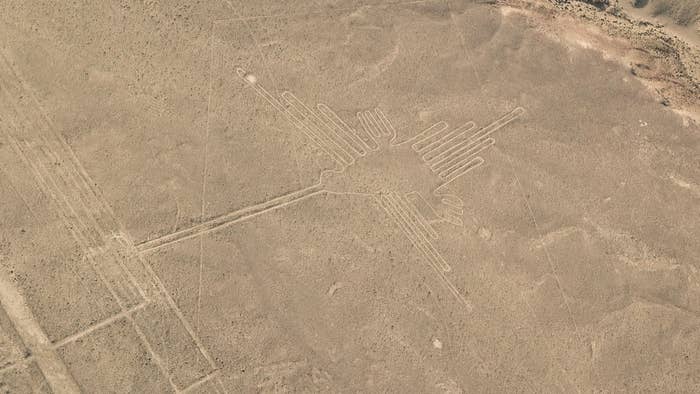
According to an announcement from Peru's Ministry of Culture, a massive carving of an ancient cat has been discovered on an arid hillside in the southern part of that country. This carving was reportedly made more than 2,000 years ago, stretches 121-feet in length and makes up part of the nation's famed Nazca Lines.
For those unfamiliar (a.k.a. those of you who haven't gone down UFO rabbit holes), the Nazca Lines are a batch of several hundred mysterious and massive geoglyphs that have been drawn into the soil in southern Peru's Nazca desert. Other artworks in the collection include a monkey, pelican, and also that hummingbird pictured at the top of this post.
This latest discovery was uncovered as maintenance work was being conducted in an area that already served as a tourist destination.
"The figure was barely visible and was about to disappear as a result of its location on a fairly steep slope and the effects of natural erosion," said a press release put out by the aforementioned ministry.
Conservation work was performed, and archeologists found lines that were between 12-16 inches wide. The ministry adds that, judging by the style of the artwork, it was created at some point within 200 B.C. to 100 B.C.
More generally, the Nazca Lines were forged between 500 B.C. and 500 A.D. by societies that made impressions in the desert floor to show a different colored dirt exposed beneath the surface. Not many ancient human-type drawings have been found, but there have been plenty of un-coverings of animals/birds/plants.
In addition to those depictions of flora and fauna, there have also been discoveries of shapes and patterns, like triangles and spirals.
"They are the most outstanding group of geoglyphs anywhere in the world and are unmatched in its extent, magnitude, quantity, size, diversity and ancient tradition to any similar work in the world," says the website for UNESCO (The United Nations Educational, Scientific and Cultural Organization). "The concentration and juxtaposition of the lines, as well as their cultural continuity, demonstrate that this was an important and long-lasting activity, lasting approximately one thousand years."
According to CNN, the lines were first discovered (well, at least by more recent peoples) in the 1920s when they were identified by Peruvian archeologist Toribio Mejia Xesspe.
On account of the fact that you get a much better view of the etchings while you're in the air, the expansion of air travel in the following decade revealed several more examples.
Oh, on that note, here's a list of some such examples that I suggest you click on, but feel free to ignore me.
In the meantime, the newly unearthed cat kind of looked like it was put together by a 1,000 ft. tall kindergartner (especially in comparison to the spider and condor examples in the just-provided-link). That fact wasn't lost on those who saw the news:

